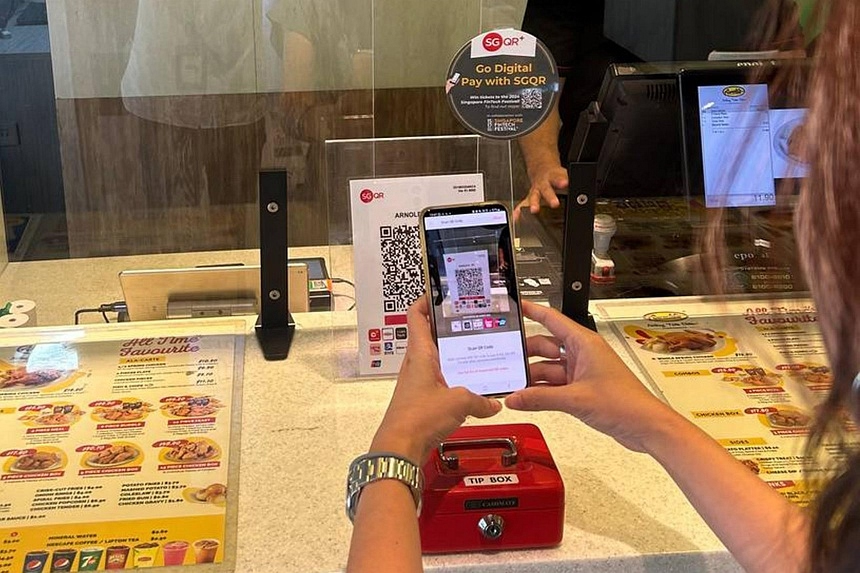The enhanced Singapore Quick Response Code Scheme (SGQR+) is going further, with local and overseas merchants standing to gain from the improvements. (straitstimes.com)
Local payment services group Nets is rolling out the commercialisation of SGQR+ in Singapore, while Singapore-headquartered fintech Liquid Group looks to take SGQR+ global with the launch of roamQR on Nov 7.
Under SGQR+, merchants receiving customer payments through QR codes need to deal with only one issuer, which is Nets.
Through Nets, merchants can then access 17 other local and international payment schemes such as DBS PayLah, OCBC Digital, UOB TMRW, Alipay and PromptPay.
Before SGQR+, merchants who wanted to accept a range of payment schemes had to deal with the different financial institutions themselves. The acceptance of payment schemes was also not uniform across merchants.
SGQR+ will be rolled out islandwide to 24,000 acceptance points or static QR points displayed at retail and food and beverage (F&B) outlets.
The enhanced payment scheme will also be extended to the hawker segment, which is separate from retail and F&B categories.
This means SGQR+ will be available to more than 35,000 acceptance points in Singapore.
In the SGQR+ proof-of-concept conducted by the Monetary Authority of Singapore (MAS) in November 2023, 75 per cent of participating merchants indicated an interest in continuing participation in the scheme, while 86 per cent of financial institutions indicated a positive user experience.
The proof-of-concept comes after MAS in 2018 introduced SGQR to combine multiple payment QR codes into a single SGQR label. This was to make it easy for merchants to accept payments digitally.
In a release issued on Nov 7, Nets said it aims to grow the number of acceptance points by 10 per cent year on year.
Mr Lawrence Chan, group chief executive of Nets, said that the SGQR+ proof-of-concept project is a milestone for digital transactions in Singapore as it shows how payments can be made more convenient for merchants.
“With Nets, each merchant only needs one commercial arrangement to accept payments from multiple domestic and inbound payment options. It also gives them access to a wider customer base and allows both merchants and consumers to transact more easily, efficiently and safely,” he added.
The islandwide roll-out, to be completed by second quarter of 2025, will have three new issuers – Singapore-based payment solutions firm dtcpay, digital bank MariBank and Maybank.
Mr Miguel Pereira Tanco, director of ZooMoov, which is a company operating rides for kids, said the firm can now accept multiple payment options with just one system.
He said Nets’ enhanced scheme simplifies the payment process and allows the company to serve more customers, whether they are locals or foreigners.
Ms Alice Liu, chief executive and co-founder of dtcpay, said: “By enabling consumers to spend their digital assets effortlessly, we hope to strengthen engagement within the local merchant ecosystem while enhancing the overall customer experience.”
As more cross-border QR linkages get established, there is room for SGQR+ to integrate with more payment schemes in the region, in turn expanding consumer options and broadening the payments network.
Liquid Group on Nov 7 announced the launch of roamQR, which it described as “the next phase of SGQR+”.
The idea behind this is to allow anyone to pay anyone with a QR code.
What this means, said Mr Jeremy Tan, chief executive of Liquid Group, is that roamQR serves as a switch. By doing so, it enables connections among various e-wallets, merchant acquirers, and national networks, so anyone who participates in this will be recognised within the network.
As the payments sector continues to heat up, local lender OCBC Bank on Nov 7 said it would enable payments into more than 50 digital wallets globally within two years, by partnering Visa Direct.
The bank said it has the first mobile banking app in Asia-Pacific that lets users send almost instant peer-to-peer transfers to both WeChat Pay and Alipay. This can be done using just the recipient’s China national identification name and mobile number.












